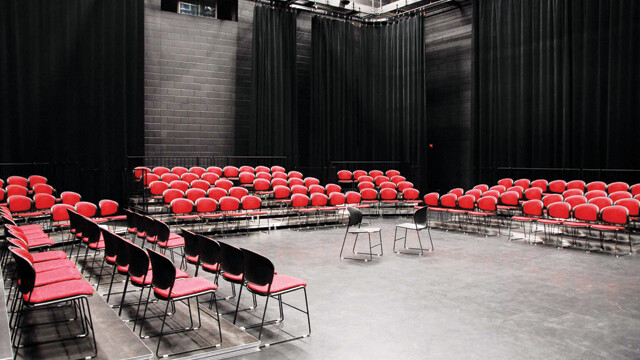Inside the 'Black Box'
250-seat theater proposed for Confluence would allow for flexibility, creativity

When JAMF Software pledged $500,000 to support the construction of a new community arts center as part of the Confluence Project, the company was given naming rights to the new 250-seat black box theater that will be built in the complex. But what is a black box theater, and what would having one mean for local actors, directors, and theatrical patrons in the community?
According to Theatre Projects Consultants, a black box theater is a “void space that may indeed be black, but isn’t always. Usually, audience seating is on the main floor, with no audience galleries.”
Local theater authority Ben Richgruber, executive director of the Eau Claire Regional Arts Center, was able to break down that lingo for the average person while describing what the venue could bring to Eau Claire. “It’s a flexible venue, literally a big black box. They can have seats against two walls, three walls, or seats surrounding the stage,” he said. “Any configuration that can be imagined can be done. That’s what makes it such a cool opportunity.”
“It’s a flexible venue, literally a big black box. They can have seats against two walls, three walls, or seats surrounding the stage. Any configuration that can be imagined can be done. That’s what makes it such a cool opportunity.” – Ben Richgruber of the Eau Claire Regional Arts Center, describing a black box theater
The idea of the black box theater is to create a space that can be manipulated to suit the actors and directors. With its popularity spreading in the 1960s and ’70s, the idea was for low-cost, experimental theater to take shape. The black walls and stage can be altered to add color where necessary, or can remain neutral and not clash with costumes, sets, or lighting. The audience being able to see the show from 360 degrees affords the directors the opportunity to open up the props, actions and directions that the actors can work with. All in all, the flexibility that Richgruber speaks of is the main goal of the space.
“Theatrically speaking, the actors and directors can get much more creative in a black box because they get to invent the space as they write the show,” he said. “If you do a show at the State Theater, the Kjer Theater, or the Oxford, you’ve got a stage, and it isn’t moving.”
Traditionally, the space has many different uses. Richgruber says that today what you see performed inside a black box theater is likely to be new theater or avant-garde theater. Local writers could use the space as a place to try out new material.
But for Eau Claire, there are a ton of opportunities outside of the theatrical realm. Richgruber pointed out that it could even be used as a comedy club or music venue.
“There’s sound equipment and lighting that can go anywhere in the room, the seating can go anywhere in the room,” he said. “It can be manipulated any way that you like.”
While the design process for the black box theater that would be part of the Confluence is on hold until the project is fully approved by the state, the collective gears are turning for Richgruber and the rest of the partners in the project. “There are a lot of really great ideas, and the black box itself doesn’t need to be complicated,” he said. “It’s that kind of flexibility that makes it work.”






















